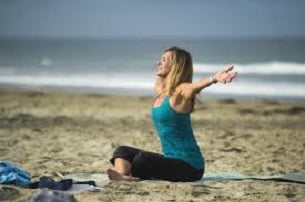Why Breathing Techniques Are An Ideal Starting Point
When you see photos of people practicing yoga in beautiful and interesting places around the world, it can be hard not to want to join in. These people tend to look so relaxed, so healthy, and so focused on wellness that you can’t help but want to emulate them and their experiences. And really, that’s one of the best advertisements there is for a yoga- and wellness-centric lifestyle!
That said, starting with an intensive yoga routine out of nowhere is easier said than done. It’s certainly possible to teach yourself some poses and routines these days and work your way up to an intermediate, and eventually even expert level. This is thanks to the prevalence of yoga apps that have made it easier to experiment with yoga, rather than commit to a whole class or program. If you’re patient with your own use of these apps, you can ultimately get good at yoga – and get to the point at which traveling to try programs or resorts in beautiful places around the world can actually make sense!
However, even if you’re able to teach yourself, it’s a good idea to start with the basics. And that means nailing down some of the simple breathing techniques that ultimately serve as the foundation of yoga (and so much other exercises). Read on for a few reasons why this should be a priority for anyone with an interest in practicing yoga on a regular basis.
Breathing Is The Foundation Of Yoga
One article on this topic put it quite nicely, stating that awareness of breath and synchronizing breath and movement is what makes yoga a yoga, as opposed to any other kind of exercise. Those who have practiced yoga regularly understand that it isn’t just a sequence of movements, stretches, and carefully held poses. Along with all of these components, proper breathing technique is essential. For one thing, focusing on breathing (as opposed to simply doing it as you always do) helps to focus the mind as a whole, which is crucial in effective yoga. Additionally, proper breathing actually affects things like bodily structure and joint alignment as we move from pose to pose. For these reasons, learning the breathing first and yoga second is actually a very strategic order.
It’s An Exercise Unto Itself
It’s easy to think of breathing merely as something we do naturally that must be controlled during yoga. However, it’s also perfectly fair to view breathing techniques as their own, independent exercises as well. This came up in a 2017 article that was actually put together for gamers who might want calm, easy exercises in the midst of their recreational activity. In that piece, Equal Breathing (or Sama Vritti) was discussed specifically, and it was referred to as being as much of an exercise as working the biceps. This may sound like a strange way to think about it, but respiration involves internal muscles, and they too can be exercised.
It Teaches You To Make Time
It should also be noted that yoga requires a time commitment, like any other exercise. And with how busy modern life can be, this is what ultimately holds a lot of people back. Keeping this in mind, committing to short but necessary breathing exercises can actually train you, slowly, to carve out time in your day for yoga. You can start with 10 minutes of breathing technique each day, progress to 15, and then start to work in longer routines once you’re actually practicing yoga. With many other kinds of exercise, there isn’t such a natural stepping stone for training you to make time.


